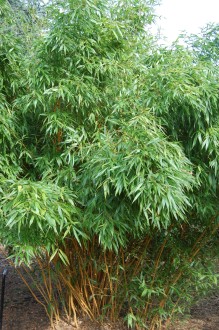Position: Full sun to partial shade
Flowering period: N/A
Soil: Moist, well drained
Eventual Height: 8m
Eventual Spread: 2.5
Hardiness: 7b, 8a, 8b, 9a, 9b, 10a, 10b, 11
Family: Poaceae
Phyllostachys bambusoides ‘Castillonis’ is a clump forming, evergreen bamboo. Its dark green, glossy leaves are opposite, linear with entire margins up t0 15cm long and 25mm broad and appear in clumps of 4 – 6. Its canes are yellow in colour, with green grooves. The plant flowers approximately only every 120 years. This plant spreads by underground rhizomes and may be invasive.
The species Phyllostachys bambusoides, commonly known as Japanese Timber Bamboo, is native to China and possible Japan. It is a symbol of Japanese culture and is the most commonly grown timber bamboo in Japan, growing up to 1m per day. Phyllostachys bambusoides ‘Castillonis’, commonly known as Castillon bamboo or Timber Bamboo ‘Castillonis’, is synonymous with Phyllostachys bambusoides castillonensis.
The etymological root of the binomial name Phyllostachys is derived from the Greek phyllon meaning ‘leaf’ and stachys meaning ‘spike’. Bambusoides is derived from the Latin meaning ‘resembling Bambusa’. Bambusa was a name for bamboo that was the result of an erroneous pronunciation of the Indian word Mambu.
The landscape architect may find Phyllostachys bambusoides ‘Castillonis’ useful as an attractive architectural plant with bright light coloured stems. It also makes an effective screening or hedging plant.
Ecologically, Phyllostachys bambusoides ‘Castillonis’ is of little wildlife value in the UK.
Phyllostachys bambusoides ‘Castillonis’ prefers moist, fertile, well-drained soils. It tolerates most pH of soil.
Phyllostachys bambusoides ‘Castillonis’ requires little maintenance. Spent stems may be removed. After flowering this plant should be cut back hard and fed with a balanced fertiliser.






My phyllostachys bambusoides castillonis flowered in 2017, did anyone else find this? I cut down all except two small canes, but they flowered too, last year, so my clump is gone!